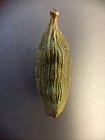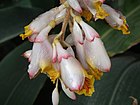Note: This is a project under development. The articles on this wiki are just being initiated and broadly incomplete. You can Help creating new pages.
Elettaria cardamomum - Ela, Cardamom
Elettaria cardamomum, commonly known as green or true cardamom, is a herbaceous perennial plant in the ginger family, native to southern India. It is the most common of the species whose seeds are used as a spice called cardamom. It is cultivated widely in tropical regions and reportedly naturalized in Réunion, Indochina and Costa Rica.
Uses
indigestion, nausea, vomiting, pulmonary disease, stomach pain, heart burn, throat troubles, congestion of the lungs, kidney stones
Parts Used
Chemical Composition
a-pinene, b-pinene, sabinene, myrcene, a-phellandrene, limonene, 1,8-cineole, y-terpinene, p-cymene, terpinolene, linalool, linalyl acetate, terpinen-4-oil, a-terpineol, a-terpineol acetate, citronellol, nerol, geraniol, methyl eugenol and trans-nerolidol[1]
Common names
| Language | Common name |
|---|---|
| Kannada | Elakki |
| Hindi | Elaichi |
| Malayalam | Elatarri |
| Tamil | Elam Ancha |
| Telugu | Elaki |
| Marathi | NA |
| Gujarathi | NA |
| Punjabi | NA |
| Kashmiri | NA |
| Sanskrit | Trutih |
| English | Cardamom, Malabar cardamom |
Habit
Identification
Leaf
| Kind | Shape | Feature |
|---|---|---|
| Simple | long and sword-shaped | The underside is paler and may have a covering of tiny hairs and it is Dark green |
Flower
| Type | Size | Color and composition | Stamen | More information |
|---|---|---|---|---|
| Unisexual | Reach over 1 m in length | pale green | 5-20 | the flowers contain both male and female parts. One of the petals is white and streaked with violet |
Fruit
| Type | Size | Mass | Appearance | Seeds | More information |
|---|---|---|---|---|---|
| oval-shape | Each fruit has three chambers filled with small aromatic seeds, each about 3 mm long | The fruits dry to a straw-brown colour and are widely used as flavouring | seeds dry to a straw-brown colour and are widely used as flavouring | {{{6}}} |
Other features
List of Ayurvedic medicine in which the herb is used
- Vishatinduka Taila as root juice extract
Where to get the saplings
Mode of Propagation
How to plant/cultivate
Cardamoms do not do well when exposed to draughts, sudden changes of temperature or direct sunlight[3]
Commonly seen growing in areas
Photo Gallery
References
External Links
- Pages that are stubs
- Ayurvedic Herbs known to be helpful to treat indigestion
- Ayurvedic Herbs known to be helpful to treat nausea
- Ayurvedic Herbs known to be helpful to treat vomiting
- Ayurvedic Herbs known to be helpful to treat pulmonary disease
- Ayurvedic Herbs known to be helpful to treat stomach pain
- Ayurvedic Herbs known to be helpful to treat heart burn
- Ayurvedic Herbs known to be helpful to treat throat troubles
- Ayurvedic Herbs known to be helpful to treat congestion of the lungs
- Ayurvedic Herbs known to be helpful to treat kidney stones
- Herbs with Seed used in medicine
- Herbs with Fruits used in medicine
- Herbs with common name in Kannada
- Herbs with common name in Hindi
- Herbs with common name in Malayalam
- Herbs with common name in Tamil
- Herbs with common name in Telugu
- Herbs with common name in Sanskrit
- Herbs with common name in English
- Habit - Herb
- Index of Plants which can be propagated by Seeds
- Index of Plants which can be propagated by Cuttings
- Herbs that are commonly seen in the region of semi-tropical
- Herbs that are commonly seen in the region of indoors in a heated greenhouse
- Herbs that are commonly seen in the region of warm shady humid place
- Herbs









